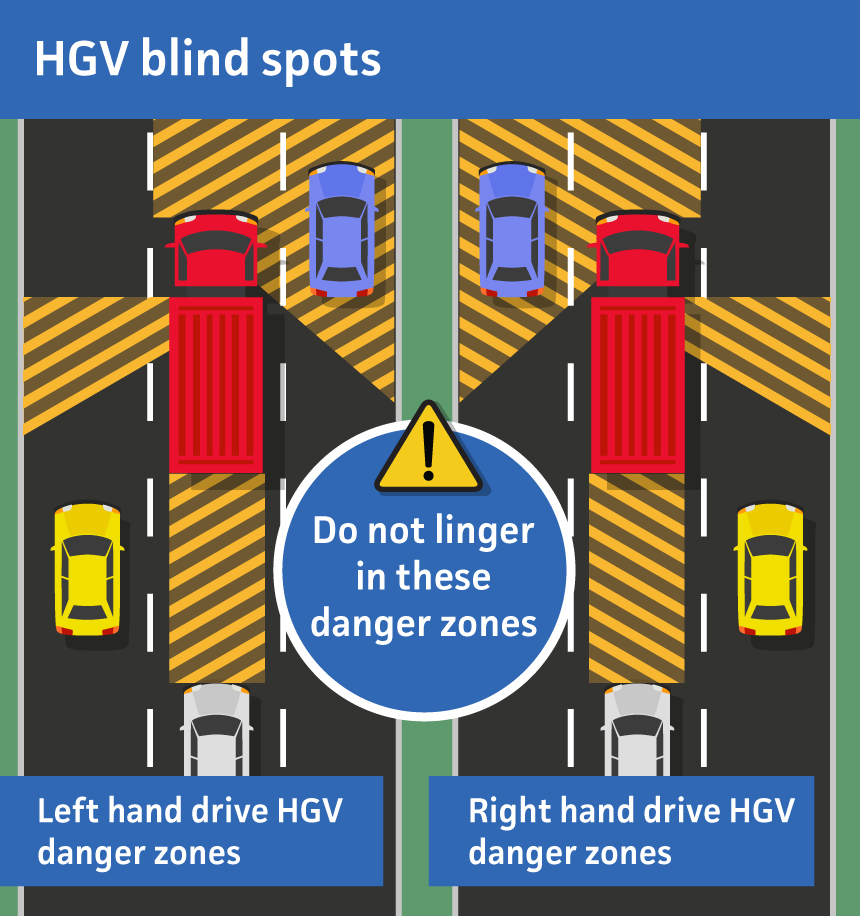HGV Blind Spots: Understanding and Managing Them
22/05/2023 00:00:00by Mark McKenna22/05/2023 00:00:00HGV Blind Spots: Understanding and Managing ThemBluedrop Services

Heavy Goods Vehicles (HGVs) are a common sight on roads across the UK. These large vehicles are essential for transporting goods across long distances, but they can also pose a significant risk to other drivers, cyclists and pedestrians due to HGV blind spots.
According to a survey conducted by National Highways, approximately three-quarters of respondents reported taking additional precautions when overtaking a HGV. However, 36% reported feeling anxious while passing these vehicles and were unaware of the total number of blind spots associated with an HGV.
Understanding and managing these blind spots is crucial to reducing the number of accidents on our roads. So, where are the HGV blind spots?
Where are HGV blind spots?
HGVs have several blind spots where the driver's view is obstructed, making it difficult or impossible to see other road users.
Here are the areas to be aware of:
Front blind spot
HGV drivers sit high up in their cabs, which means they can’t see anything within a short distance (approximately two feet) in front of the vehicle.
Rear blind spot
The rear blind spot is larger than the front blind spot (up to nine feet away), and HGV drivers are often unaware of vehicles, pedestrians or cyclists following behind them.
Left and right side of the HGV
The side blind spots can extend along the entire length of the vehicle. Drivers have restricted visibility, which means they may not see other vehicles, cyclists or pedestrians travelling alongside them.

Now that we know where the blind spots are, what can we do to avoid accidents and manage them? Here are some tips for both HGV drivers and other road users:
Managing HGV blind spots
To avoid accidents and manage blind spots, there are several things that both HGV drivers and other road users can do. HGV drivers should be aware of their blind spots and take steps to minimise the risk of accidents.
For HGV drivers:
1. Use mirrors
One of the most important things that drivers can do is adjust their mirrors correctly. Mirrors should be positioned so that the driver has a clear view of the sides and rear of the vehicle.
2. Use technology
Many modern HGVs are equipped with cameras, sensors and other safety features that can help to reduce blind spots and improve visibility. For example, some HGVs are equipped with side-view cameras that provide a clear view of the blind spot on the passenger side of the vehicle. Rear-view cameras can also be used to help drivers see obstacles and other vehicles when reversing.
3. Eliminate distractions
HGV driving is already challenging enough. To be a safe and effective driver, it is important to stay focused and limit any distractions that could affect performance.
4. Be aware
Be aware of the surrounding environment, particularly when driving through urban areas where pedestrians and cyclists are more likely to be present. Always double-check your blind spots by looking again before turning or changing lanes.
For other road users:
1. Stay visible
Try to make yourself as visible as possible to HGV drivers. When overtaking a large vehicle, move steadily and signal in plenty of time so that they know you're coming. If cycling or walking at night, wear reflective clothing and use lights.
2. Avoid blind spots
Never assume that an HGV driver has seen you. Drivers should avoid travelling in the blind spots of HGVs and should make sure to give these vehicles plenty of space when passing or changing lanes. It is also important to avoid sudden manoeuvres that could surprise the driver of an HGV, such as cutting in front of the vehicle or suddenly braking.
3. Be patient
Be patient, avoid overtaking on blind bends or hills and always give HGVs space to turn, as turning manoeuvres can take much longer than standard cars and can be dangerous if undertaken too quickly.
4. Communicate
If you need to cross the road in front of an HGV, make eye contact with the driver and wait for them to signal that it is safe to cross.
Driving a safer future
HGV blind spots are a significant risk to road users, and it is important to be aware of these dangers. Ultimately, reducing the number of accidents involving HGVs requires a collective effort from all road users. By taking the necessary steps to manage blind spots and improve visibility, we can work towards a safer future for all road users.
If you wish to find out about Bluedrop’s Fleet Insurance for your HGVs, visit our Haulage Insurance page.
Return to blog menuWant to find out more about Bluedrop's Fleet Insurance?
Call our friendly team now for the right insurance cover - at the best price
+441489780491
Calls recorded for training and quality.



 Privacy and Cookie Policy
Privacy and Cookie Policy